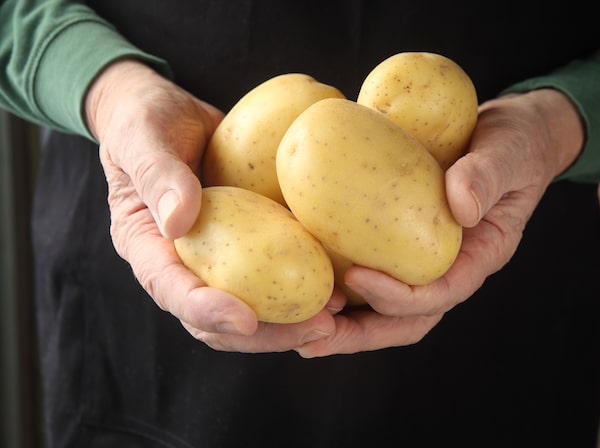
Potatoes can be a healthy option. They offer niacin, vitamin B6, folate, vitamin C and magnesium. They're a great source of potassium,nebari/iStockPhoto / Getty Images
Potatoes seen at Linkletter Farms in Summerside, P.E.I., Tuesday, April 23, 2013.The Globe and Mail
The question
I’ve heard potatoes aren’t nutritious. Are some healthier than others?
The answer
White potatoes are often regarded as the “white bread” of vegetables, a starchy food with little nutritional value. The truth is, potatoes are good for you provided, of course, they’re not laden with butter and cream or deep-fried in oil.
One medium sized baked Russet potato – with the skin – has 168 calories, no fat, 37 grams of carbohydrate and four grams of fibre. If you’re worried that a potato contains more carbohydrate than other starchy foods, it doesn’t. You’ll find roughly 37 grams of carbs in one cup of cooked quinoa, three-quarters of a cup of cooked brown rice and one cup of cooked pasta. And unlike white bread, the starch in potatoes hasn’t been refined to deplete nutrients.
Potatoes also deliver niacin, vitamin B6, folate, vitamin C and magnesium. They're a great source of potassium, which helps regulate blood pressure. One medium white or red-skinned potato, with the skin, has more than double the potassium of a medium-sized banana, 950 milligrams versus 422 mg. (Adults need 4,700 mg of potassium a day.)
Six so-called ‘bad’ foods that deserve a place in your diet
Nutrition in white potatoes vs. sweet or purple potatoes
Some types of potatoes offer even more nutrition. Sweet potatoes, which are related to the morning glory, are high in beta-carotene, an antioxidant thought to guard against certain cancers. A half cup of mashed sweet potato has 15 mg of beta-carotene. There’s no official recommended intake for beta-carotene, but three to six milligrams daily is thought to help lower the risk of chronic disease. Yams, which belong to the lily family, have little beta-carotene, but are a good source of fibre and potassium.
Purple potatoes – increasingly available in grocery stores and farmer's markets – have a purple-coloured skin and flesh. They're loaded with anthocyanins, the same phytochemicals found in berries, red and purple grapes and red wine. Studies suggest that higher intakes of anthocyanins may lower the risk of heart disease and stroke.
Glycemic index of potatoes
Potatoes vary when it comes to glycemic index (GI), a measure of how a food affects your blood glucose. Foods with a high GI value (e.g. white bread, table sugar) cause your blood sugar to spike quickly. The carbohydrate in foods with a low GI (e.g. steel-cut oats, brown rice) is released more slowly into the bloodstream. A high glycemic diet has been linked to a greater risk of Type 2 diabetes, cardiovascular disease and certain cancers.
White potatoes – boiled, baked or mashed – score high on the GI scale. Sweet potatoes have a low glycemic index; new potatoes have a medium to low glycemic index. According to University of Toronto researchers, however, the GIs of Russet and red-skinned potatoes are reduced to the low to moderate range if you eat them cold (pre-cooked) or reheated. Cooling potatoes alters their starch structure, causing carbohydrate to be absorbed more slowly into the blood. Adding vinegar to potatoes (think potato salad) also lowers their glycemic index.
One tip: leave the skin on when cooking potatoes. The skin contains fibre and nutrients, and helps retain the vitamin C.
Leslie Beck, a Toronto-based private practice dietitian, is director of food and nutrition at Medcan. Follow her on Twitter @LeslieBeckRD
Sign up for the weekly Health & Wellness newsletter for the latest news and advice.
 Leslie Beck
Leslie Beck